30 Years continued 3
Remembering three decades of marches, activism, and celebration.
By David Fagan and Skip Teauxmelou
Photos by Dalton DeHart, Blase DiStefano, and Fred Paez
Previous
Page 1 • 2 • 3
Timeline • Sources
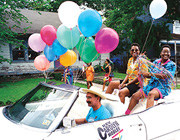
In early October polls showed Whitmire leading Welch and vulnerable on only the one issue—her support for the failed gay rights referendum. Attempting to capitalize on that perceived weakness, Welch attacked Whitmire’s support of gay rights and reminded voters of Whitmire’s 1983 visits to Montrose gay bars to thank the gay community in her successful re-election campaign that year. Welch commented, “There is no way that you could hog-tie, hobble, and drag me into a gay bar at 2 o’clock in the morning to give them thanks.”
Comments of that kind were common in the Welch campaign, a fact that likely contributed to the gaffe on October 24, 1985, which may have doomed any hope Welch had of unseating Whitmire. When he thought his microphone was off, Welch said on live television that one solution to AIDS would be to “shoot the queers.” By the next morning, people were wearing T-shirts that said “Louie, Don’t Shoot!” In contrast to the enormous support for Welch’s version of morality at the January referendum, Welch and his “Straight Slate” were defeated in the November election. The political career of Shoot-the-Queers Louie was a closed chapter. Despite this victory, it was not until 1998 that the results of the 1985 referendum were reversed by Mayor Lee Brown’s executive order.
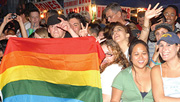
1987’s parade was dampened by a frightening statistic: Houston’s 1,200 cases of AIDS, the fourth largest in the nation. In 1991, the Q-Patrol, which was formed in response to a rise in hate crimes, including three murders in 1990 and 1991, were responsible for many arrests for antigay activity. Increased cooperation between the gay community and the Houston Police Department evolved. This, and increasing pressure from the gay community, culminated in “Operation Vice Versa” in which officers, posing as homosexuals, found themselves the target of homophobic violence. Five undercover officers were attacked, sprayed with Mace, bludgeoned with a baseball bat and a tree branch. During the decade that followed, relationships between HPD and the gay community continued to improve, until openly gay and lesbian police officers marched as a contingent in the 2001 Gay Pride Parade, followed in 2002 by Houston’s out firefighters.
If there had been an award for the most spontaneously exuberant parade, the 2003 parade would have won it. All that summer the nation had anticipated the Supreme Court’s announcement of its review of Lawrence vs. Texas. The case stemmed from an incident at east Houston’s Colorado Club Apartments on Normandy Road. Tyrone Garner and John Lawrence had been arrested by Harris County constable officers, who were responding to a “weapons disturbance” statement by neighbor Roger David Nance (which subsequently was determined to be false, and for which he served 15 days in jail for filing a false police report). The officers had entered the apartment’s bedroom, where they saw the two men engaged in “deviant sex” in violation of Texas Penal Code Section 21.06, which penalized oral or anal sex between two men (no mention of such sex between a man and a woman). It was a misdemeanor, punishable by a fine of $500.
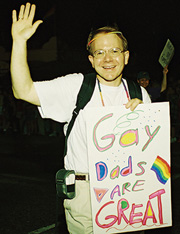 The constitutional implications were immediately apparent. Lawrence and Garner were convicted and fined, but were successful in their appeal that overturned the conviction. The two then engaged the help of the American Civil Liberties Union in filing suit against the state of Texas. This was the first case in the nation in which a complaining party had actually been wronged by an existing statute. Earlier cases in Texas had been dismissed or upheld by the U.S. Supreme Court, as well as the Texas State Supreme Court. As the Justice’s session ran deep into the summer, watchers anxiously waited for the opinion to be handed down. Then, on June 26, just two days before that year’s Pride parade, the majority opinion, written by Justice Anthony M. Kennedy, was handed down. It invalidated Section 21.06 of the Texas Penal Code and recognized homosexual rights to privacy and fundamental rights to equality under the law.
The constitutional implications were immediately apparent. Lawrence and Garner were convicted and fined, but were successful in their appeal that overturned the conviction. The two then engaged the help of the American Civil Liberties Union in filing suit against the state of Texas. This was the first case in the nation in which a complaining party had actually been wronged by an existing statute. Earlier cases in Texas had been dismissed or upheld by the U.S. Supreme Court, as well as the Texas State Supreme Court. As the Justice’s session ran deep into the summer, watchers anxiously waited for the opinion to be handed down. Then, on June 26, just two days before that year’s Pride parade, the majority opinion, written by Justice Anthony M. Kennedy, was handed down. It invalidated Section 21.06 of the Texas Penal Code and recognized homosexual rights to privacy and fundamental rights to equality under the law.
At the City Hall rally in Houston, defendants Tyrone Garner and John Lawrence, their lawyer Mitchell Katine, and the national media were present. From New York to San Francisco, the newspapers picked up the picture of the jubilant embrace of Garner and Lawrence in front of Houston’s City Hall. Two days later, still jubilant, they served as Honorary Grand Marshals of the Pride parade.
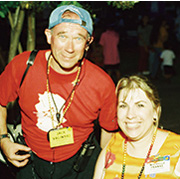
The city and the gay community have both come far, much… or perhaps, most… of it directly or indirectly through the parade. As it has in the past, its look and its route may change but the parade remains a constant, a moment of community celebration—its purpose to celebrate individual pride, commemorate the community’s achievements and struggles, and educate society for the liberation of all people.
All that and a parade, too.
Previous
Page 1 • 2 • 3
Timeline • Sources
Sources:
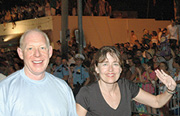
Anderson, Pokey,
“An Idiosyncratic Tour of Houston,” Livable Houston Magazine, http://livablehouston.com/good/articles/anderson.html.
Bernabo, Marc, “Gays March Proudly,” Dallas Morning News, 25 June 1972, http://www.newsbank.com.
Darbonne, Sheri Cohen, “The First Two Years of Houston Pride,” 1991 Pride Guide, 1.
Gay Political Caucus, “Dear Business Owner” (GPC letter dated 05 May 1980), Botts Collection, Organizational Vertical Files Box 12, Gay Pride Week, 1980 Folder.
Houston Digest, “City Officials Urged not to Adorn Annual Gay Pride Parade Floats,” 10 June 1985, unknown p.
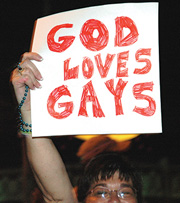 Lane, Ed, “The Politics of Pride: A Historical Overview of the Political Events that Shaped Houston’s Gay and Lesbian Pride Parade.” Unpublished Paper, University of Houston, 2000.
Lane, Ed, “The Politics of Pride: A Historical Overview of the Political Events that Shaped Houston’s Gay and Lesbian Pride Parade.” Unpublished Paper, University of Houston, 2000.
Meyer, Walter M.D., Evangeline Emory, M.D., Collier Cole, Ph.D., Eric Avery, M.D., Robert White, M.D., and Alice Webb. “The Gender Treatment Program at University of Texas Medical Branch Hospitals in Galveston, Texas,” XVII Harry Benjamin International Gender Dysphoria Association Symposium 2001, http://www.symposion.com/ijt/hbigda/2001/01_huang.htm.
Sears, James T., Rebels, Rubyfruit, and Rhinestones: Queering Space in the Stonewall South. New Brunswick, N.J.: Rutgers University Press, 2001.
Shivers, Rob, “Houston Gays Open 1st Community Center,” The Advocate, 20 December 1972, 8.
Assorted Articles from The Houston Chronicle, The Houston Post, Houston Voice, OutSmart, This Week in Texas.
Personal Communication with Phyllis Frye, Ray Hill, and Jack Valinski.
Special Thanks to Larry Criscione of the Charles Botts Memorial Library and Archives and Judy Reeves of the Gulf Coast Archives and Museum for their encouragement and support.










